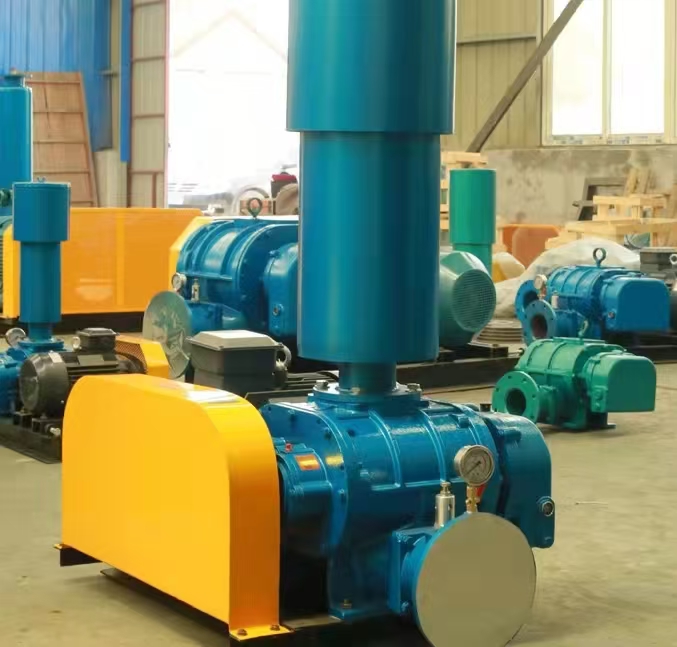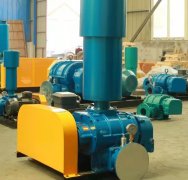**Is there pressure when the Roots blower reverses**
The Roots blower is designed as a unidirectional rotating device. If it undergoes a reverse rotation (running in the opposite direction to the design direction), its pressure characteristics will change, but it usually cannot establish effective pressure properly and may even damage the equipment. The following is a detailed analysis:
---

**1、 Pressure performance during reversal**
**1. Pressure or zero**
-During normal operation, the Roots blower pushes gas from the inlet to the outlet through rotor engagement, and the pressure is generated by the resistance at the rear of the system (such as pipes and valves).
-When reversing:
-The airflow direction is opposite, and the exhaust port becomes the intake port, making it difficult to effectively compress the gas.
-The intake port becomes the exhaust port, which may suck in outside air but cannot form a stable pressure.
-* * Actual pressure * *: Usually close to atmospheric pressure (0 bar gauge pressure), and may even be negative pressure (if the system seal is poor).
**2. May be accompanied by abnormal phenomena**
-* * Reverse airflow * *: Placing your hand on the exhaust port will feel "suction" instead of "blowing".
-* * Increased noise * *: Abnormal engagement of the rotor causes metal friction noise.
-Abnormal current: The motor may experience overcurrent or overheating due to changes in load.
---
**2、 Why can't reversing establish normal pressure**
1. * * Damage to gear meshing relationship**
-The two rotors of the Roots blower maintain a fixed phase difference (such as 120 ° or 180 °) through synchronous gears, ensuring non-contact operation.
-When reversing, the direction of force on the gear changes, which may cause:
-The rotor collides and the gap disappears.
-Gear misalignment prevents effective gas sealing.
2. * * Incorrect direction of gas flow**
-During normal operation, the gas is forcibly pushed towards the exhaust side.
-When reversing, the gas flows randomly in the chamber and cannot form stable transport.
3. * * System resistance cannot be utilized**
-The pressure of Roots blower depends on the rear end resistance, and when reversing, the airflow is turbulent, and the resistance cannot be effectively converted into pressure.
---
**3、 The harm of reversal**
|* * Problem * * | * * Consequences * *|
|------------------|--------------------------------------|
|* * Rotor collision * * | Impeller wear and deformation, rotor needs to be replaced|
|* * Gear damage * * | Broken teeth or misalignment, causing the fan to jam|
|* * Bearing overload * * | Abnormal stress, shortening service life|
|Sealing failure | Oil seal/mechanical seal leakage, lubrication system contamination|
---
**4、 How to determine if the fan is reversing**
1. * * Observe the turn mark**
-The casing or motor is usually marked with a * * rotation direction arrow * * (such as "CW" clockwise or "CCW" counterclockwise).
2. Airflow testing**
-Short time jog start, feel the exhaust port with your hand:
-* * Normal * *: Strong airflow is emitted.
-* * Reverse * *: No wind or suction.
3. * * Listen to the sound**
-Normal: A uniform buzzing airflow sound.
-Reverse: metal friction noise (rotor collision).
---
**5、 Measures for handling after reversal**
1. * * Immediately shut down * * and cut off the power supply.
2. * * Swap the phase sequence of the power supply * * (any three-phase motor can swap two phase lines).
3. * * Check for damage * *:
-Manually turn the disc to confirm if the rotor is stuck.
-Check if the gears and bearings are abnormal.
4. * * Retest the machine * *:
-Confirm the correct steering during no-load operation, and then gradually load.
---
**6、 Special case: reversible Roots blower**
-A very small number of customized models are designed for bidirectional rotation, but they must meet the following requirements:
-The rotor profile is symmetrical (such as a two blade profile).
-The gearbox lubrication system is compatible with both forward and reverse rotation.
-Ordinary Roots blowers are strictly prohibited from reversing**
---
**Conclusion**
-When reversing, there is no effective pressure. The airflow is reversed and cannot be pressurized normally.
-Risk: May cause damage to the rotor, gears, and bearings.
-Solution: Immediately correct the steering and check the equipment status.
If you notice a reversal accompanied by abnormal noise, it is recommended to contact professional maintenance personnel for inspection!



